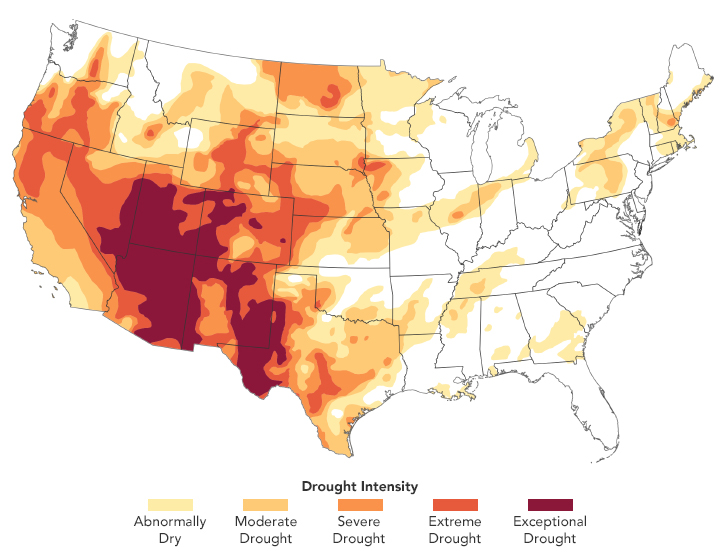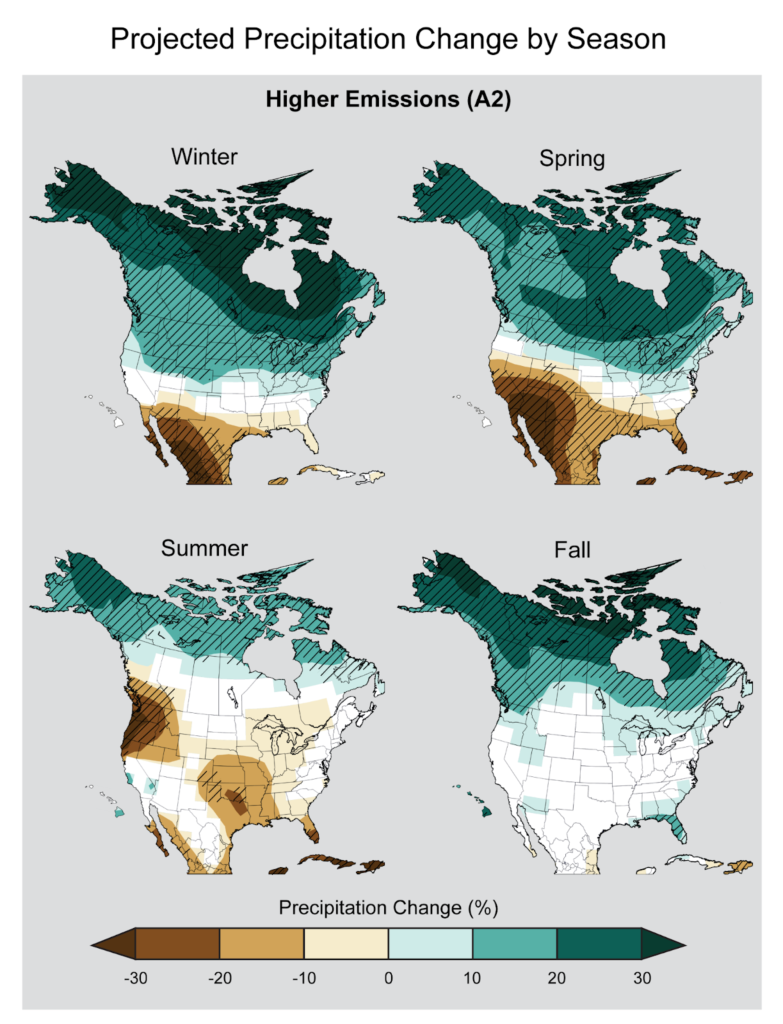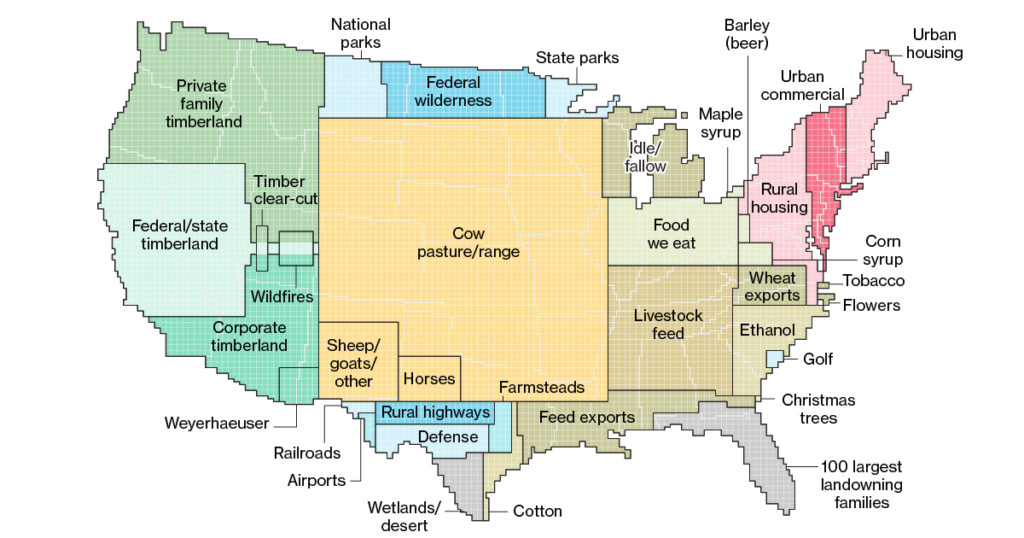What Is Desertification?
Desertification is the process by which land turns into a desert. In other words, desertification is when land degrades over time and becomes more arid, causing the land to be less fertile and productive.
Desertification threatens human subsistence, as it makes natural resources including food and water much more difficult to obtain.
Arid areas in the United States are experiencing desertification, which threatens to become more intense in the future.
Learn more: What is Desertification?
Table of Contents
Fast Facts about Desertification in the U.S.
Where Is Desertification Happening?
Why Is Desertification Happening in the U.S.?
Impacts of Desertification
Solutions to Desertification in the U.S.
Fast Facts about Desertification in the U.S.
- Around one-third of the land in the United States is affected by desertification (Reuters 2007).
- Around 40 percent of land in the U.S. is considered arid or semi-arid and is at risk of desertification (USDA 1999).
Where Is Desertification Happening?
Desertification occurs in drylands, areas that get less rain (precipitation) than is evaporated or consumed by plants through part or the entire year. Drylands have very limited water and soil moisture.
Desertification has actually already occurred in the U.S., with devastating effects. The 1930s Dust Bowl occurred as farming areas in the American Midwest became desert due to a combination of drought and poor farming practices. The Dust Bowl caused millions of people to leave their homes and travel to other areas not plagued by drought or extreme dust storms.
Desertification is still occurring in the U.S. today, mainly in the western U.S., where over half of the land area is arid, semi-arid or dry sub-humid (USDA 1999).
The following map shows the intensity of a drought that occurred in the western U.S. in spring of 2020. In the fall, the drought got worse in the southwest and spread eastward into the Great Plains. This drought makes these regions vulnerable to desertification. This is a particular problem in these regions, as much of the United States’ agricultural production occurs in the west.

Source: NASA Earth Observatory
Why Is Desertification Happening in the U.S.?
Desertification is caused by multiple factors, including natural causes and human activities. The factors discussed below are some of the major drivers of desertification in the U.S., but do not represent a comprehensive list.
Climate Change
As climate change continues and temperatures rise, land becomes more arid and more vulnerable to desertification. The amount of precipitation (rain) that is occurring in deserts today is generally much lower than the amount of rain a half century ago (UNFCCC 2020).
Extreme weather events like drought are a major driver of desertification, and are becoming more intense and more frequent as a result of climate change (UNFCCC 2020). As much of the U.S.’s deserts are already susceptible to drought, climate change may cause more extreme drought in this area.
Flooding caused by climate change can also contribute to loss of soil through landslides and erosion, which causes land degradation and desertification.
The map below shows projected precipitation changes in the U.S. if we continue to produce high carbon emissions. Increased periods of extreme precipitation (turquoise) will likely lead to flooding, while increased drought and lack of precipitation (brown) will lead to increased aridity. Both of these factors may lead to increased desertification.

Source: Kunkel 2013
Additionally, wildfires are becoming more frequent as a result of climate change. The USDA, in partnership with the National Forest Service, predicts that a temperature increase of 1 degree C would increase the median area of land burned per year by as much as 600 percent.
Wildfires can lead to infertile soil, as fire harms soil health even below ground. Wildfires also lead to loss of soil, as less vegetation cover allows wind to pick up dirt and sand and create wind-driven (aeolian) desertification. A study of the Southern Rockies region in the western U.S. found that climate change increases soil loss above historic levels, and that wildfires increase soil loss by an additional 3 to 5% (Litschert et al. 2014).
A lack of trees also contributes to desertification as it decreases soil moisture. Less vegetation increases the land’s albedo (the land’s ability to reflect sunlight), causing radioactive cooling, which reduces rainfall and therefore reduces soil moisture (Charney 1975).
Population Growth and Urbanization
Higher urbanization and increased population growth leads to higher resource extraction and increased pressure on surrounding agricultural areas (Abdelbagi 1982). More resource extraction like logging, farming, and land clearing leads to faster desertification, as does land clearing.
Higher populations create higher vulnerability to desertification. While the U.S. population growth rate slowed slightly in 2021, the first slowing since the nation’s founding, the U.S. population has been on a trend of increasing population for many years (Rogers 2021).
The map below shows land use in the U.S. As the midwest gets less precipitation and desertification makes cropland less and less available, more people will be forced to move into cities or to live on infertile land without resources.
Urbanization (an increase in developed versus rural land) is already increasing in tandem with population growth. This also contributes to loss of land available for farming, and contributes to desertification through increased pollution of natural resources like soil and water (EPA 2012).

Source: Bloomberg
Ineffective Land Management & Resource Use
There are many agricultural practices that degrade land and contribute to desertification. First, removing protective layers of vegetation on top through tilling erodes land and degrades the soil, leaving infertile soil levels below to dry out in the sun (Winslow et al. 2004).
The use of chemical fertilizers and pesticides also works to degrade soil, as they kill off helpful microorganisms in soil and remove crucial nutrients for plant growth (Joko et al. 2017).
Overgrazing livestock additionally erodes land and makes it more difficult for new plants to grow.
As more land is degraded, more land must be turned into farmland and used more intensively. This increased land-use intensity in turn worsens desertification, as intensive agriculture works to degrade land.
Improper farming practices were a large driver of the Dust Bowl in the 1930s, as excessive plowing and a lack of crop rotation drained soil of its nutrients. As soil eroded, it began to blow away.
Impacts of Desertification
Desertification is already having severe impacts, and will continue to cause harm both to human economies and subsistence styles, and the environment.
Reduced Food Security
As agriculture becomes more difficult on increasingly degraded and desertified land, food scarcity increases.
Desertification is also linked to a lack of water, both for drinking and irrigation. This lack of water desertifies land and makes it more difficult to grow food crops. For example, many farmers in California are experiencing an extreme lack of water for their farms due to drought. As California is one of the major producers of agricultural products in the U.S., with $45.2 billion in sales in 2017, the drought and resulting desertification threatens to impact the availability of certain types of foods across the country (USDA 2021).
Increased Disease
Desertification may cause increased risks of water and food-borne diseases. This is partially due to a lack of clean water (Mirzabaev et al. 2019).
Increased dust in the air can result in respiratory problems or heart disease (Zhu et al. 2022). The United States already experienced this during the Dust Bowl, when many residents of farms experiencing dust storms developed silicosis, or “the brown plague,” from breathing in dust particles. This killed many people (Klein 2019).
Restricted Economic Development
Desertification will have a large economic toll on areas that are economically dependent on livestock or agriculture.
Increased drought is already creating large economic losses in the U.S. According to NOAA, drought is causing a $9 billion loss in the U.S. every year. In California alone, a lack of water led to a loss of half a million acres of land used for agriculture.
This directly impacts farmers who lose crops due to drought, or ranchers who need to spend more money to procure food and water for their animals. These losses will continue to increase as desertification and drought intensify, and more land becomes unable to support farming and ranching.
For more information on the impacts of desertification, read “Desertification: Definitions, Causes, Impacts, and Solutions.”
Solutions to Desertification in the U.S.
Many solutions have been developed and some have been implemented to try and address desertification in the U.S.. This article discusses a few solutions, but a wide variety of community-based approaches are needed to address the problem of desertification.
Implementation of Regenerative Agricultural Practices
Regenerative agriculture is agricultural practices that restore the land, rather than depleting the land of vital resources.
Regenerative practices that restore soil health include agroforestry (planting trees among crops), low or no-till farming, planting cover crops, and using natural, chemical-free fertilizers and pesticides. Planting drought-resistant crops may additionally work to protect communities against the effects of desertification.
Read more: What Is Regenerative Agriculture?
One innovation that works to increase the use of smart, sustainable farming is the Land-Potential Knowledge System (LandPKS), whose app helps people learn whether their land can be farmed sustainably, and provides information on best practices for the soil type in their area.
Sustainable Wildfire Control
Because wildfires contribute to desertification (as discussed above), wildfire control is a crucial tool in fighting desertification in the United States.
However, some wildfire control practices, such as cutting down trees and burning them, actually harms the plants and soil underneath, and thus does not aid in fighting desertification (Havrilla et al. 2017). Instead of burning trees to control fires, a 2014 paper suggests turning the trees into mulch and spreading it along the ground. This helps native plants grow, and can promote soil moisture, nutrient content and cooler soil microclimates.
Government Regulation and Aid
In California, one of the states hardest hit by desertification, many attempts to conserve water and address desertification have been enacted by the government.
The California Sustainable Groundwater Management Act was enacted in 2014 to try and preserve groundwater over time by putting used water back in water basins. This preservation of groundwater will be a crucial tool in ensuring water is available for drinking, irrigation, and prevention of desertification.
California State also provided farmers, the main users of water in the state, with $80 million in grants to install lower pressure irrigation systems that use less water. By conserving water, farmers help ensure healthier, wetter soil that is slower to turn into desert.